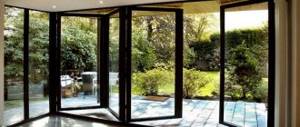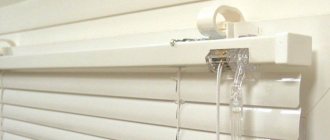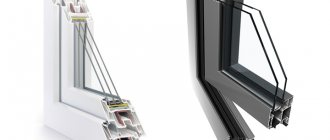Causes of window fogging
Excessive moisture should be named first. A person himself evaporates about 2–3 liters of water per day. And this is on average under normal conditions. Living plants in pots also produce moisture.
If we talk about an apartment or house, then the microclimate is also affected by using a washing machine, cooking, taking a bath or shower. The relative humidity in residential premises should be in the range of 50-65%.
In connection with the first point, the question arises as to why excess water remains in the room. Apartments and houses usually do not have good ventilation. Fresh air enters there through windows and doors and moisture is removed in the same way. This, as can be seen from practice, is not enough.
Temperature change. People notice condensation on plastic windows mostly during the cold season or in the off-season. Why is that? Condensation is equally affected by both humidity and temperature.
There is such a concept - dew point. This is the temperature at which the vapor contained in the air collects into droplets of water, since the air cannot hold it. The glass surface is the coldest place in the house.
At a sufficiently high relative humidity, when the temperature of the glass inside the room reaches a certain level, it passes the dew point and we get condensation on the windows. A demonstration of this phenomenon can be a glass vessel taken out of the refrigerator - the same processes occur with it.
Another factor that is directly related to temperature is the location of the house according to the cardinal directions. Windows facing north will certainly be colder than those facing south.
Accordingly, the moisture that has already formed on them will evaporate much longer, which means it will have a longer effect on the double-glazed window itself.
What to do if PVC windows sweat?
Before proceeding directly to solving the problem, you should find out the humidity level and air temperature in the room. Thus, excess or lack of humidity is measured with a special device - a hygrometer. On average, air humidity in ordinary residential apartments should range from 40 to 60%.
Air temperature also affects the sweating of plastic windows: the higher it is, the more the glass sweats in the cold season. This indicator is measured with a simple thermometer for an apartment. According to experts, the optimal air temperature is on average 18-21 degrees. Deviation to a smaller or larger direction threatens excessive formation of drops on the glass of plastic windows.
Thus, you should monitor humidity and air temperature indicators, and not allow deviations from the norm. If you know why a plastic window in your house sweats, you should take measures to eliminate the cause:
- Replace your windows with quality products with at least two cameras. Energy-saving film must be glued to the glass;
Design of a two-chamber plastic window
- Seal the slopes from the inside and outside. So, all the cracks are covered with cement mortar, the outside of the window is finished with foam plastic, and the inside with glass wool;
- Houseplants should be removed from window sills where glass sweats. They only increase excessive moisture formation in the room;
- Ventilate the room more often. At least 2-3 times a day for half an hour. If it is winter, leave the room during this time to avoid catching a cold from hypothermia.
Airing the room
As a rule, these measures are enough to stop plastic windows in a private house or apartment from sweating.
Ways to eliminate condensation
Before describing methods of dealing with condensation, a little should be said about the double-glazed windows themselves.
The purchase and installation of two- and three-chamber double-glazed windows, especially in regions with cold climates, will help to a large extent to avoid the appearance of condensed moisture on the windows.
A single-chamber double-glazed window simply will not cope with this task.
Tips and methods:
- Adequate ventilation should be provided. In the absence of a normal room ventilation system, you can do the following: open the windows twice a day for 15–20 minutes. Simple ventilation removes used air along with water vapor and brings in fresh air. Forced ventilation has proven its effectiveness.
- This is a duct system that has fans built into it. If it is available, there is no need for normal ventilation. Even modern ventilation, using humidity and temperature sensors, can regulate the microclimate in various rooms according to your wishes: heat, dry, humidify, etc.
- The next important factor is the finishing of window slopes, window sills and external ebbs while simultaneously insulating them. All together, this makes it possible to reduce heat loss and, accordingly, move the dew point back.
- You should also pay attention to the balcony. It is better to order glazing of the balcony (possibly with single-chamber double-glazed windows) with simultaneous insulation of the floor, walls and ceiling of the balcony. In this case, condensation will certainly not form on the glass inside the room.
- The location of batteries and heating devices is also important. It is advisable that convectors, radiators, radiators are located under the windows and the window sills should not completely block them from above. This will create a constant thermal curtain in front of the windows. Curtains and curtains are also an obstacle to heat loss. You should also be careful with open water surfaces, such as aquariums.
- Don't forget about such little-used items as shutters, blinds and roller shutters. Since an air gap is formed between them and the windows, we get an additional barrier to heat loss. Roller shutters doors, among other things, can perform an aesthetic function, because they are produced according to individual orders and can be painted in different colors, bear photo printing, etc.
Taken together, these methods will help get rid of the unpleasant problem of condensation and even avoid unnecessary spending on heating.
Source: steklandia.ru/poleznoe/problema-kondensata-na-steklopaketah/
The main reasons why plastic windows in an apartment sweat from the inside
- Surface temperature
But no matter how much you breathe on the glasses from the sun on a hot summer day, they will not fog up, since their lenses are just as warm. The same thing happens with windows: the greater the resistance to heat transfer, the less likely it is to fog up.
Then why do plastic windows sweat in the apartment and mold on the slopes? The culprit is moisture accumulated on plastic that can absorb it. If the surface is constantly moistened, after some time mold will inevitably appear on the windows. Its spores easily enter the human body through breathing and can cause serious diseases - allergies, asthma and others.
What to do to prevent windows from sweating?
- Choose a warm profile.
- Order special glass and filling.
- Inspect sealing elements in windows in a timely manner and replace them.
- Adjust the fittings.
- Finish the joints according to technology.
- Check that there are no obstacles to the flow of heat.
To counteract the penetration of cold, warm profiles are installed: from PVC - four- and five-chamber, with a thickness of more than 70 mm, from laminated wood - from 78 mm, aluminum with a thermal bridge - 30-35 mm.
Use single- and double-glazed windows. With the transition from one package to another, the temperature of the inner surface of the glass increases. In this case, low-emissivity K- and I-glasses are used, the space between them is filled with argon, krypton or their mixtures.
We found out why plastic windows and wet slopes sweat in the apartment. Condensation forms in the coldest areas. For double-glazed windows, these are the lower corners of the seals, where water vapor, combining with cold air, can even form ice. To avoid this, you can replace aluminum spacers with warm polymer ones that have low thermal conductivity. True, this is not a panacea for saving condensation, but this way you can raise the temperature in the edge zone by a couple of degrees.
As a result of using low-quality or old seals, as well as unadjusted fittings, micro-blowing occurs, which leads to an increase in overcooled areas. This is why plastic windows sweat from the inside in an apartment in winter. To avoid this, choose high-quality frost-resistant seals for installing double-glazed windows and periodically call a specialist to adjust the fittings.
Plastic windows sweat due to insufficient foaming of the joints. In this case, to prevent fogging and the formation of ice, it is recommended to foam the joints with high-quality foam and follow the technology when installing windows and insulating slopes.
In addition to the listed factors, we note another reason why plastic windows sweat from the inside in an apartment in winter - the formation of condensation on the windows is influenced by the width of the window sill. It should be made in such a size that it does not block the rising flow of warm air from the radiator. The length and density of curtains is chosen using the same principle. Decorative screens under the window are also installed so that they do not block the flow of heat.
One of the effective ways to prevent the formation of condensation on windows is to supply warm air from the radiator through air ducts directly through the window sill to the window.
- Room temperature
Another reason why plastic windows sweat from the inside in an apartment in winter is an unproductive heating system. In winter, the window surface temperature depends on the internal air temperature. And if the temperature in the apartment is 24-25 degrees and efficient ventilation and heating systems are provided, then conditions for moisture condensation on the plastic windows will not arise, and therefore they will not sweat.
- Air humidity
In addition to the tightness of double-glazed windows, high-quality installation and sufficient heating, the formation of condensation is affected by the humidity in the room. It depends on water vapor entering along with the supply of outside air, and vapor formed as a result of human activity - breathing, washing, cleaning, showering, cooking, etc.
Recommended articles on this topic:
- Quick apartment renovation
- Stages of renovation in an apartment
- Turnkey cosmetic repairs
For example, let’s take an average apartment in central Russia. In winter, with a standard air exchange of about 110–140 m3/h, 25–35% humidity is set, 30% is considered optimal. The dew point temperature depends on the humidity and air temperature in the room. At +20 degrees and normal humidity up to 30%, it will be low; accordingly, the likelihood of condensation even in the edge zones of double-glazed windows is reduced. If the humidity increases to 50%, the dew point temperature increases to 10 degrees. Here.
The reasons for the increase in moisture content in the indoor air, resulting in plastic windows sweating in the apartment:
- plastic windows sweat when there is insufficient air circulation due to irregular ventilation of the apartment;
- due to faulty exhaust hood and clogging of the ventilation shaft, remodeling, non-working exhaust devices above the stoves and axial fans in bathrooms, etc.;
- plastic windows sweat from a large number of plants in the room and frequent washing;
- wet finishing and construction work can also be the reason why plastic windows in an apartment sweat from the inside in winter;
- low temperature in the apartment due to insufficient heating.
Fighting condensation on plastic windows
Condensation is the most common problem that manufacturers of PVC windows and their consumers have to face.
It should be noted that condensation is not only an unpleasant aesthetic defect, but can also cause dampening of building structures and, as a result, the appearance of mold!
According to standards, the temperature of indoor air in premises should not be lower than +18°C; in a number of regions, Territorial Construction Standards (TSN) have been adopted, which prescribe the temperature of residential premises not lower than +20°C.
If the temperature is below standard, then you need to check the heating system, because this may cause condensation.
Condensation forms primarily at the bottom of the glass unit. Due to convection, cold air accumulates in the lower part between the glasses.
Therefore, the bottom and lower corners of a glass unit are the coldest parts of a modern window structure.
Since the question of the regional zone arises often, the Gosstroy of the Russian Federation gave an explanation on this problem in letter No. 9-28/200 dated March 21, 2002:
1. Condensation in the edge zones on the inner surface of double-glazed windows during the winter period of operation is usually associated with the presence of an aluminum spacer frame in their design and the convection conditions of the gas-air filling.
International standards (ISO, EN standards) allow temporary formation of condensation on the inner glass of a double-glazed window.
But the standards for window units do not normalize the formation of condensation, since this phenomenon depends on a complex of third-party factors: air humidity in the room, design features of the junction points of window units, insufficient air convection along the inner glass (due to a wide window sill, improper installation of heating devices ) and etc.
At the same time, GOST 24866-99 does not allow condensation to form inside the glass unit, which should be considered a significant defect leading to a decrease in standardized performance characteristics.
As for high air humidity, this phenomenon is characterized by the following main reasons:
- Insufficient air exchange due to too tight windows and, as a result, poor performance of exhaust ventilation.
- Increased humidity in building structures due to recently completed construction or renovation work. Building structures retain moisture for one to two years after completion of work!
- Peculiarities of everyday behavior of residents. For example, a greenhouse on the windowsill or drying baby diapers in the kitchen...
New standards SNiP 23-02-03 “THERMAL PROTECTION OF BUILDINGS” have determined the design parameters of the relative humidity of premises to determine the dew point and temperature requirements on the inner surface of windows:
5.9 The relative humidity of internal air to determine the dew point temperature in places of heat-conducting inclusions of enclosing structures, in corners and window slopes, as well as skylights, should be taken:
- for premises of residential buildings, hospitals, dispensaries, outpatient clinics, maternity hospitals, boarding homes for the elderly and disabled, comprehensive children's schools, kindergartens, nurseries, kindergartens (plants) and orphanages - 55%, for premises kitchens – 60%, for bathrooms – 65%, for warm basements and underground areas with communications – 75%;
- for warm attics of residential buildings – 55%;
- for premises of public buildings (except for the above) - 50%.
5.10 The temperature of the inner surface of the structural elements of the glazing of windows of buildings (except for industrial ones) must be not lower than plus 3°C, and of opaque window elements - not lower than the dew point temperature at the design temperature of the outside air in the cold season, for industrial buildings - not lower than zero ° C.
What other errors can lead to condensation? It is necessary to check the room for the presence of a cold surface!
The reasons for the appearance of cold surfaces may be related to resistance to heat transfer and ventilation of structures. They may be as follows:
Errors in window manufacturing:
- A “cold” double-glazed window with low heat transfer resistance was installed, which does not meet the standards.
- Violation of clearance tolerances, use of non-standard seals or incorrect installation of hinges are the reasons leading to window blowouts.
- Non-opening sashes have drainage holes measuring 5x20 mm instead of holes for draining the cavity between the edges of double-glazed windows and the folds of profiles measuring 5x10 or with a diameter of no more than 8 mm.
That is, we are talking about a violation of the provisions of GOST 30674-99, clause 5.9.5 and clause 5.9.6 regarding the system of ventilation and drainage holes. We sent out a letter on this topic, and we want to remind you again: according to GOST, there are drainage holes and there are ventilation holes. These are different types of holes!
In the letter of the Gosstroy of Russia No. 475 dated September 10, 2002, paragraph 2 states that “if the sashes do not open, the dimensions and location of the holes in the lower profile of the frame should not contribute to overcooling of the lower edge of the double-glazed window.”
Confusion in this issue is often associated with terminology: in GOSTs there is no concept of “fixed” glazing or window, but there is the concept of “non-opening sash”!
That is, in the version that in everyday speech we call “a fixed window or glazing” in the terminology of the standards - “non-opening sash”!
Solving condensation problems
The homeowner will need to determine why plastic windows in a private home are fogging up. If it is not difficult to solve the problem with humidity, then if the installation or design features of the windows are incorrect, you have to correct the incorrect installation or replace damaged and low-quality frames with double-glazed windows .
We normalize the humidity and temperature in the room
A common reason why plastic windows fog up indoors is high humidity and temperature in the room. It will be necessary to measure the average humidity and temperature of the house using hygrometers. If the humidity in the room is more than 70%, it is necessary to ensure regular ventilation of the rooms, and also try to remove sources of high humidity, which can form from aquariums, come from the bathroom, or enter the room from the ventilation system.
Related article: Electric drives for windows and transoms
Many models of plastic double-glazed windows have a room microcirculation , which allows you to provide a flow of fresh air into the room, in turn, this allows you to solve problems with condensation. Being in this microcirculation mode, plastic windows provide the flow of necessary fresh air into the room, but at the same time in winter they do not cool the room.
Proper window ventilation
By organizing high-quality ventilation of plastic windows, you can solve problems with condensation, which will no longer cause problems for homeowners. To ensure proper ventilation, various devices are used:
- The combs are installed on the frame, opening the doors to the required distance.
- The presence of a window allows you to organize high-quality ventilation of the room.
- Thanks to the use of appropriate fittings, the doors can be opened completely for ventilation or to an opening width of 5-10 centimeters.
- With slot micro-ventilation, the sash moves away from the frame by a few millimeters, which is enough for proper air exchange in the room, and the double-glazed windows will no longer cry or get wet.
- The presence of a ventilation duct allows you to regulate the amount of fresh air entering the room.
Self-regulating ventilation consists of several valves in the chambers of the frame, and is capable of increasing or decreasing the volume of air entering the room, depending on the intensity of the air flow.
Installation of ventilation valves
Installing a ventilation valve on plastic frames is not difficult. The valve kit includes the necessary seals and fasteners, which will allow you to do all the work yourself. The tools you will need are a Phillips screwdriver, a sharp construction knife and double-sided tape.
The ventilation valve is installed on the top panel of the opening sash or balcony door. The seal is carefully cut to size and then glued to the plastic profile. There should be no gaps between the seal and the valve, which could impair the quality of ventilation in the house. The valve is attached with self-tapping screws to the flap, in which several holes are made with a drill to supply air from the street. The valve itself has numerous channels through which fresh cold air from the street will heat up and enter the room already warm.
By organizing such proper ventilation in the room, it will be possible to completely solve the problems with condensation collecting on the glass, which forms on the windows due to high humidity. Subsequently, the homeowner will also need to control the level of humidity in the room by adjusting the amount of fresh air entering the rooms.
Problems with profile installation
If the homeowner has solved the problems with humidity, and condensation still forms on the windows, then, with a high degree of probability, the cause of the problem is poor-quality installation of the frame. In this case, it will be necessary to contact a specialist who, after inspecting the glass unit, will be able to assess the correctness of the installation. In some cases, a small adjustment of the glass unit will be sufficient, which will solve the problem of misalignment when installing windows.
Getting rid of condensation on windows is not difficult . The homeowner will only need to determine why the frames and glass are sweating, provide high-quality ventilation in the room, or make the necessary adjustments to the profile, which will improve its tightness, eliminating the occurrence of glass fogging. The seals should be washed regularly, lubricating them with appropriate impregnations, which will extend the life of the rubber bands that provide the necessary sealing of the sashes and glass units.
Installation errors
- Errors when making an assembly seam: incomplete foaming, which reduces heat transfer resistance; poor protection from external climatic influences, which leads to foam blowing or getting wet; absence or poor vapor barrier, which also leads to the insulation getting wet, but with steam from the side of the room.
- “Cold bridge”, when, due to improper design of the junction unit, the window ends up in a cold, sometimes even negative temperature zone of the wall. This reason often occurs when heavy condensation appears.
- Blowing through a wall structure, for example, a brick one, through empty seams - “empty space”. This phenomenon can be encountered in houses of the socialist period - the builders did not fill the vertical seams well. But this has also become a problem in new construction with multi-layer walls, when the mineral wool is covered on the outside with brick or other cladding. In this case, the insulation must be ventilated, and when the windows are placed in the plane of the insulation, they may be exposed to cold air from the side of the junction. In this case, during installation, it is better to separate the wall from the junction unit with a layer of foamed polyethylene 6-10 mm thick.
- A wide window sill prevents the convection of warm air from the radiator in the window opening.
Therefore, we can give the following tips to eliminate the possibility of condensation:
- If, after all, condensation is a consequence of increased air humidity, then this cause must be eliminated due to the increased likelihood of mold appearing in the room.
- To reduce indoor air humidity and move the dew point to lower temperatures, we recommend installing a Regel-Air climate valve or ventilating the room for 10 minutes twice a day.
- Heat losses with such ventilation are insignificant even in winter and amount to no more than 3 degrees.
- The intensity of ventilation of the room must be increased during repair work.
- The window sill should not be very wide and prevent the passage of warm air.
- To allow warm air to pass through to the window, place the curtains at some distance from the window sill.
- Decorative screens on heating radiators should not interfere with the passage of heat flows from the radiators.
- It is necessary to periodically check the exhaust ventilation system in your home or apartment.
One of the most effective ways to combat condensation will be to install a window with a five-chamber Favorit system, developed by THYSSEN POLYMER GmbH (Germany) specifically for Russia.
The temperature on the inner surface of the profiles directly depends on the heat transfer resistance of the profile system. For example, we can consider two cases - at an external temperature of -26? C and at -31? C (at an internal temperature of +20? C and a relative humidity of 55%).
The dew point will be +10.7?C. Temperatures on the surfaces of a standard binding (three chambers and a width of about 60 mm) and a five-chamber binding with a heat transfer resistance of 0.78 m2? C/W will be as follows:
| Binding option | Temperature on the binding surface at an outside temperature of -26 C | Temperature on the binding surface at an outside temperature of -31 C |
| Binding with 0.63 m2 C/W | 11.82 C | 9.79 C |
| Binding with 0.78 m2 C/W | 13.22 C | 12.48 C |
Source: ashdom.ru/articles/fenstr_1.htm
Causes of fogging
There are several most common reasons for fogging of plastic windows. They often appear in several places at once.
The first reason can be called humid air in the apartment. You can determine the presence of high humidity by using a device such as a hygrometer. When measuring readings in an apartment, 55% is considered the norm . In winter, data may be lower. Increased humidity becomes a serious problem that needs to be addressed.
Another reason why plastic windows sweat from the inside in an apartment is the lack of air circulation. This may be caused by errors in the installation of products and problems with engineering systems, in particular heating. There are reasons such as:
- wide window sills that impede circulation;
- heating radiators incorrectly installed;
- lack of tightness.
As a result of freezing, condensation is created on those windows whose surface is not blown with warm air . Drops of condensation may appear inside between the glass panes if the double-glazed window remains cold despite the warmth in the apartment. You need to find what prevents it from warming up.
The same effect can also be caused by the opposite phenomenon in the form of overheating. This already happens when all the heat from the battery goes directly to the glass unit. In this case, moisture appears inside between the glasses. Thus, damage is caused by both too long and too short window sills.
When the air in a room is not ventilated, due to the constantly hanging water particles that are present in it, a lot of condensation forms and settles on the surface of the windows. When air cools, water vapor becomes highly concentrated. If air currents move, this will not happen. High air humidity is caused by poor ventilation . Most old ventilation systems were designed for wooden window frames, while plastic ones require a more powerful circulation system.
Condensation between the glass may appear during apartment renovations.
A combination of many factors leads to this, and to solve the problem it is worth covering the windows with polyethylene. All moisture will settle on its surface.
Poor-quality fittings lead to deterioration of insulation when closed, when the window does not close tightly.
It is necessary to monitor the condition of the rubber seals . They deteriorate much earlier than other parts, therefore, the glass freezes faster and ice can even form on them.
Humidity on the glass may appear due to a mismatch between the dimensions of the glass unit and the profile. The climate of the region is an important factor when choosing windows, therefore, for places with harsh winters, you should not install too thin cheap double-glazed windows. This significantly affects thermal conductivity.
Poor installation often becomes the reason why plastic windows in a private home fog up. Illiterate installation leads to an increase in accumulated condensate. The main installation errors include:
- weak connection between the frame and the sash;
- the double-glazed window is installed directly in the wall;
- cracks have formed at the installation sites or the building has deformed the opening due to subsidence;
- the assembly seam is poorly sealed.
Related article: Cosmofen for cleaning plastic windows
By using the services of specialists in your field, many problems can be avoided. They can help with the selection and finishing of the window sill after installation. But despite this, time can still play a role, and then you will have to look for ways to get rid of fogging.
Why do plastic windows sweat from the inside and how to fix it?
If a double-glazed window fogs up not from the outside, but between the panes, then there can only be one reason - defective double-glazed windows. This is the manufacturer's fault, since the double-glazed window must be sealed.
This problem can be solved simply - by replacing the double-glazed window (only it, and not the entire window structure - the profile remains the same). The double-glazed window is installed within a few minutes - to do this, the glazing beads are removed.
It is clear that this work must be carried out by specialists. In addition, if you contacted a qualified company, then the replacement of a defective leaking double-glazed window will be free of charge - after all, this defect is covered by a guarantee (it must be stated in the contract).
If the windows constantly fog up, then the culprit may be a single-chamber double-glazed window. Experts generally do not recommend using them in residential areas, since they do not retain heat well enough.
This happens because there is only one layer in the profile, and also because of the minimum distance between the glasses. Savings are not welcome here, especially since the service life of high-quality plastic windows is measured in decades.
Why do plastic windows sweat?
There was no condensation on the old wooden windows, but it appeared on the new plastic ones. So the reason is in the windows themselves? You're right. Old wooden windows were not so airtight; there was ventilation from micro, and sometimes not more :), cracks. And the new ones fit so tightly that they do not allow air to penetrate from the room to the outside. This is how humidity accumulates in the apartment.
Since the glass on the window is the coldest surface in the apartment, condensation forms there.
The first thought that comes to mind is to make the glass not so cold. This can be achieved by increasing the number of air chambers in the double-glazed window. Much less condensation accumulates on triple and double glazed windows than on single-chamber windows.
The second reason may be poorly made slopes. If they are not insulated well enough, then naturally they will freeze, leaving drops of water on the surface. Although slopes for plastic windows are easy to make with your own hands.
Reasons for fogging of plastic windows
There can be many reasons why plastic windows sweat from the inside. And to eliminate the problem, you cannot do without identifying the causes. So, the problem may occur due to:
- Increased humidity in the air in the room - for example, when cooking, drying clothes, and so on.
- Air circulation problems in the apartment. If in winter the radiators are only slightly warm, and it is very cold outside, then the plastic windows cannot be heated to the proper extent.
- If the radiators are hot and the windows still fog up, you need to check the window sill - it may turn out that its overhang is too large and blocks the flow of heat to the window area. Protective screens on batteries can also lead to this - because in this way the heat spreading throughout the apartment does not cover the lower part of the window, which is why condensation forms here.
- Lack of high-quality ventilation - it may become clogged or not work at all, so moist air cannot be extracted.
- Plastic windows may fog up if the apartment or balcony is being renovated, or immediately after it is completed. After all, all freshly laid finishing materials (wallpaper and even ceramic tiles) release a large amount of moisture into the room, which will settle on the windows.
Incorrect installation of a plastic window. This means that your windows were installed with a gross violation of technology - poor-quality sealing of the gap between the profile and the window opening.
In addition, the low tide is very often installed incorrectly - it is simply screwed to the window. The ebb should be placed on a pre-prepared mortar base - this will create a sealed layer, protect it from moisture and cold, as well as from noise in case of strong wind.
The window can also be installed out of level - the resulting misalignment leads to the fact that the sealing gaskets of the window sashes do not fit tightly.
Low-quality fittings can also play a role - because of them, the window sashes will not close tightly. Fittings installed in violation of the rules will have the same effect.
Improper performance of work on insulation of external or internal slopes. They definitely need to be insulated and this should be done efficiently.
Foam plastic is suitable as external insulation. You should also use cement mortar - it is used to seal the cracks where the window meets the opening. When working with internal slopes, foam plastic is not used - here preference is given to basalt slabs or glass wool (mineral insulation).
Poor quality seal - then a gap appears between the glass unit and the frame through which cold air passes.
Incorrect adjustment of a plastic window - insufficient fit of the sashes, incorrectly installed fittings, and so on.
Reasons for window fogging from outside
The main reasons why plastic windows sweat in a private house or apartment:
- poor ventilation;
- low or sudden changes in room temperature;
- An error was made during installation.
The first reason is poor ventilation of the room. It is this that removes excess moisture from the apartment. If the ventilation does not work well, the air humidity quickly increases and thus condensation occurs on the window.
You can check how well the ventilation is working using a paper napkin. It is brought to the ventilation grille, if it is attracted, then everything is in order, and if not, then it is necessary to clean the entire system.
Installing a fan on the grill will significantly improve the extraction of humid air.
In many old houses, ventilation was achieved by leaking windows and doors. But plastic windows are made completely airtight, which disrupts the ventilation system.
If there is no ventilation in the house, then daily airing of the room (20 minutes a day) will help. Heat losses during this time will be insignificant.
Many double-glazed windows have a special system called “winter ventilation mode”. When you set the handle to a certain position, the window moves away a little and the room is ventilated. Often this system causes problems with fogging, as many people simply forget to switch from summer to winter mode.
Advice! Always keep an eye on the boiling kettle, turn it off on time, do not cook food for a long time without a lid, and do not dry clothes on radiators. All this greatly affects the fogging of windows.
Installing a hood in the kitchen or air conditioners in the living rooms will also help solve the fogging problem.
Attention! Do not ventilate the room during precipitation, when the humidity outside is much higher than indoors.
The second reason is a poor-quality foundation and close location to the basement. Together they can also cause fogging of plastic windows. Solving this problem will be much more difficult.
In new buildings, glass units sweat due to insufficiently dry walls and ceilings. Condensation may also appear after repairs (fresh wallpaper, various putties, etc.).
The third reason is low room temperature.
Good heating after ventilation will quickly solve this problem with dry air. What else you can do to prevent windows from sweating is to point a fan at them or install an additional heater.
To keep the room warm for as long as possible, it must be properly insulated. It is best to insulate the wall from the outside (from the street side), since then the dew point will move closer to the outer edge of the wall and the windows will stop sweating altogether.
In the summer, double-glazed windows fog up mainly only due to the lack of ventilation or ventilation during the preparation of large quantities of food (canning).
They also sweat due to the dense arrangement of flowers or office files. All of them prevent warm air from the battery from passing to the glass.
The fourth reason is poor quality installation. During the installation of plastic windows, workers made mistakes. For example, there is a gap between the frame and the window opening. Atmospheric precipitation enters the cracks and drafts draw moisture into the room.
Poor-quality fittings or those installed in violation of the rules will not allow the window to close tightly, which will also affect the increase in humidity.
Insufficiently insulated slopes also affect the fogging of double-glazed windows. It is best to insulate external slopes with polystyrene foam, and the contact points between the window and the opening are covered with cement mortar and polyurethane foam. Internal slopes are insulated with glass wool or basalt slabs.
Many people like to make wide window sills. But because of this, it begins to cover most or even the entire battery, as a result the glass does not warm up and it fogs up. The problem is solved by making holes in the window sill or installing a convection grill.
How to eliminate fogging of plastic windows - we solve the problem
To prevent plastic windows from fogging up, a number of preventative measures can be taken. So, if the window is already installed and the problem does not bother you too much, then follow two simple steps:
- Remove all potted indoor plants from the windowsill. Both plants and wet soil provoke condensation.
- Ventilate your apartment regularly, especially if the humidity in it temporarily increases for some reason.
If you are just planning to install a plastic window, then immediately check that all work is carried out carefully and in accordance with the technology:
- choose at least a high-quality 2-chamber double-glazed window, ideally with energy-saving film. The best option is considered to be a vacuum double-glazed window;
- carry out high-quality work on insulating slopes: polyurethane foam is carefully sealed both inside and outside the room, and then a suitable insulation is added;
- the place where the ebb is attached is also covered with cement and insulated with polystyrene foam;
- The area where excess foam protrudes from under the window sill is also carefully plastered - this eliminates the effects of cold in this area.
As for the main recommendations for eliminating condensation on plastic windows, they are as follows:
- if the air temperature outside allows it, then it is advisable to keep the windows in the “ventilation” mode all the time;
- constantly use the hood in the kitchen during cooking, ventilate the premises regularly;
- reduce the width of the window sill or move the radiator away from the wall, install convection grilles in the window sill or drill holes. It may also be necessary to remove decorative grilles;
- check the functionality of the apartment ventilation - a thin sheet of paper should stick to the ventilation grille. If this does not happen, the ventilation system requires cleaning;
- if a defect is found in the design of a metal-plastic window or there are inconsistencies in the technology of its installation, contact the company that carried out the work - their responsibilities include eliminating the inconsistencies;
- regularly check the wear of the fittings - adjustment or replacement of components may be required;
- do not forget to switch metal-plastic windows to winter operating mode. To do this, you will need a hex key - it is inserted into the eccentric at the end of the window and then turned.
As you can see, there are two main reasons why condensation collects on plastic windows - either incorrect work on installing the metal-plastic structure or its defectiveness (wear), or too high humidity in the room.
So if you choose a quality product and ensure proper installation, there is a high probability that the windows will not fog up.
And if you also ensure compliance with the temperature regime and high-quality ventilation of the balcony, then the problem will be completely solved - you will forget about unpleasant streaks on the glass and dampness.
Source: balkonsami.ru/osteklenie/montazh-i-remont/pochemu-plastikovyie-okna-poteyut-iznutri.html
Reasons for windows fogging in winter
The appearance of a water film on windows facing the street is a natural phenomenon for modern double-glazed windows and wooden blocks. This is how the difference in air temperature inside and outside the room manifests itself. The same factor speaks in favor of the high tightness of the window structure. The accumulation of condensation on the side of the room, on the contrary, indicates a problem. The abundance of moisture on the glass, the joints of the PVC frame and the window sill is the cause of dampness and a decrease in temperature, as well as a comfortable environment for the development of pathogenic bacteria and mold fungi.
There are three causes of fogging.
The abundance of condensation on plastic and wooden windows is favorable for the development of mold
Marriage
Despite being more airtight than wood, PVC is also subject to expansion and contraction as temperatures fluctuate. If the window is defective, this process will not take place without consequences for the material and the structure as a whole - the joints will separate, air exchange will be disrupted, and condensation will begin to accumulate between the panes. This problem cannot be solved by partial replacement - you need to completely change the PVC block.
Poor quality installation
Incorrect installation of the window structure is accompanied by:
- the appearance of cracks;
- deformation of the seams of the window block;
- disruption of the air circulation system.
Such defects are resolved under warranty, since the installation specialists made a mistake. However, to identify the cause, it will be necessary to conduct an examination that will confirm or refute the fact that the window was installed in violation of technical requirements.
High humidity
If the humidity in the room reaches 70–90%, in winter this will lead to condensation on the glass, since the temperature difference during this period reaches 10–20 °C. The problem is aggravated if the house is new - moisture continues to evaporate from the material, and the concrete still shrinks. Poor sealing of floors, window joints with load-bearing walls, and a large number of indoor plants on window sills also contribute to an increase in humidity levels.
Evaporation of moisture from potted indoor plants increases condensation on windows
Video: condensation on windows
What to do if the windows in your house sweat
So, we found out that windows in a private house sweat for two reasons: humidity and low glass temperature. Accordingly, the struggle for microclimate comes down to increasing temperature and decreasing humidity.
You can increase the glass temperature in the following ways:
- We replace old windows with plastic 2-chamber windows with energy-saving glass. If plastic windows are already installed, then you can simply replace the double-glazed windows with more energy-efficient ones. (radical but effective way)
- We dismantle the windows and install them with a shift towards the room. (also radical way)
- Window sills should not interfere with proper air convection. Make sure that the window sill does not cover the battery by more than 2/3.
- Make sure that thick curtains do not block the radiators.
- Raise the temperature in your home.
We fight moisture in the following ways:
- We check the operation of the hood, if there is one. If there is no hood, then it is better to make one. While there is no hood or it is not working efficiently, you can open the damper in the fireplace - the fireplace draft can partially serve as a hood.
- Ensure an influx of fresh air by installing supply valves on all window sashes, or turn on micro-ventilation mode in the windows (if available), simply open the window slightly to ventilation mode.
- Get rid of sources of moisture (get rid of leaks, flowers in pots, aquarium, etc.)
- Make sure that the interior doors are not airtight and have at least 2-3 cm gaps between the leaf and the floor.
- Ventilate your home regularly.
We figured out why plastic windows sweat in a private house and how to deal with this phenomenon.
Source: okna-lider.com/pochemu-poteyut-okna-v-chastnom-dome/
Fogging of plastic windows in the house: causes of the phenomenon
Experts identify several of the most common causes of sweating windows:
- Insufficient air in the room. Air circulation is not strong enough to remove excess moisture from the room. This is often observed in winter, when all the cracks are tightly closed: the slightest draft will not enter the house. Excess moisture simply has nowhere to go, so it accumulates on the window glass;
- Low level of vapor permeability of walls. Modern finishing materials for house facades, as a rule, provide good sound and thermal insulation, but they do not allow the wall to “breathe”. Preliminary priming of walls, non-woven, vinyl wallpaper - all these elements interfere with proper ventilation in a private house or apartment. The moisture has no choice but to condense in the form of drops and streams on the glass;
Non-woven wallpaper is the enemy of vapor permeability
- Unreliable plastic window design. A classic double-glazed window has two, sometimes even three chambers. This structure ensures strength and functionality, as well as sufficient vapor permeability. But unscrupulous window dealers sell single-chamber products that guarantee windows to fog almost all year round, not counting a couple of summer months;
Types of plastic windows
- Incorrectly insulated slopes. Before the onset of cold weather, the cracks in the window opening must be sealed with cement mortar, and the outside insulated with high-quality mineral material: basalt tiles, polystyrene foam, glass wool.
Basalt slab is an excellent material for insulating plastic windows
Now that we know why plastic windows in a private house sweat, it will be much easier to eliminate this nuisance.
Related article:
How to adjust plastic windows yourself? In a separate publication you can find detailed instructions on how to adjust windows in different situations.
Plastic windows leak when it rains
If it happens that during rain water flows through plastic windows, and you don’t know what to do. Don’t rush to panic, we will help you fix this problem and tell you why moisture is getting in.
Reasons for window leaks:
- Installation errors. Most likely, even when installing the window, the technology of insulation and sealing of seams was violated and because of this the plastic window is leaking.
- The seal has lost its properties, has become depleted, and has dried out. But this only happens if the sealing rubber has been in use for a long time.
- Incorrectly made slopes.
- There is a small amount of foam in the openings or it is of poor quality.
- The drainage is poorly inserted, or it cannot cope with such a volume of water, or it is completely clogged.
- In addition to the leakage of a plastic window during rain, there is another cause for concern - rubbing and fogging of the glass from the inside, the appearance of condensation.
Reasons for the appearance of moisture inside PVC windows:
- Poor quality glass. Often, unscrupulous manufacturers make it from cheap and low-quality materials; subsequently, the double-glazed window does not fully perform its heat-protective function, the glass freezes and condensation appears.
- Insufficient ventilation. You just need to skillfully use the microventilation mode, ventilate the rooms regularly, 10–15 minutes of ventilation per day will be enough.
- Increased humidity in the house. Especially in the kitchen, while cooking or boiling water.
- Incorrect installation, the window is blown out in places and moisture loss is inevitable in winter.
- If a window leaks during renovation, this is normal, because building materials contain moisture and gradually release dampness to the air.
How to identify the cause of fogging
Most likely, the problem of condensation formation on glass occurs with a certain frequency. In the morning - in the bedroom, in the evening on the balcony, kitchen or living room. By analyzing the time and frequency of droplets appearing, you can determine the exact cause of their appearance.
Sweat in the morning
The phenomenon of dew formation on grass reflects the process of droplets forming on glass in the morning. The central heating system does not provide temperature control. The concentration of thermal air indoors at night and the lowest possible temperatures outside create a “dew point” and the formation of droplets.
Condensation in only one room
If the windows in one room cry more than in the others, this means that air exchange in this room is impaired or the humidity level is increased.
Factors influencing fogging:
- Presence of an indoor aquarium.
- There is a clothes dryer.
- Thick curtains that do not allow air to pass through.
- A large number of indoor flowers.
The kitchen windows are sweating
The kitchen is a room with high humidity. Therefore, the kitchen is more likely to leak. If you encounter such a problem, most likely the hood cannot cope with the amount of steam from the kettle, stove and oven.
Related article: PVC window sales techniques











